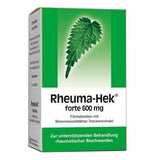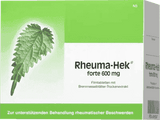RHEUMA HEK forte 600 mg film-coated tablets, dried nettle leaves,rheumatic fever treatment, rheumatism treatment
Rheuma-Hek® 268 mg hard capsules, dried nettle leaves,rheumatic fever treatment, rheumatism treatment.
Active substance: dry extract of stinging nettle leaves.
Areas of application: For the supportive treatment of rheumatic complaints.
For dried nettle leaves,rheumatic fever treatment, rheumatism treatment risks and side effects, read the leaflet and ask your doctor or pharmacist.
Status: 11.2014. Strathmann GmbH & Co. KG, 22459 Hamburg, Sellhopsweg
Areas of application:
- Rheumatic complaints, supportive treatment Instructions for
use:
The total dose should not be used without consulting a doctor or pharmacist are exceeded.
Type of application?
Take the medicine with liquid (e.g. 1 glass of water).
Duration of use?
The duration of use depends on the type of symptoms and/or the course of the disease. If the symptoms persist, you should see your doctor.
overdose?
An overdose can cause gastrointestinal problems, among other things. If you suspect an overdose, contact a doctor immediately.
Forgot to take?
Continue taking it as normal (i.e. not double the amount) at the next prescribed time.
In general, pay attention to a conscientious dosage, especially for infants, small children and the elderly. If in doubt, ask your doctor or pharmacist about any effects or precautions.
A dosage prescribed by the doctor may deviate from the information on the package leaflet. Therefore, since the doctor adjusts them individually, you should use the medicine according to his instructions.
mode of action:
How does the ingredient of the medicine work?
The ingredients come from the nettle plant and act as a natural mixture. About the plant itself:
- Appearance: herbaceous plant up to 1.5 m tall with pointed, dark green leaves; pronounced network nerves; Stinging hairs on the stem and underside of the leaf
- Occurrence: Europe and Asia
- Main ingredients: fatty acids, silicic acid, phytosterols, tannins
- Plant parts and preparations used: extracts and tinctures from leaves, roots and herbs
. The tannins and fatty acids contained in nettle inhibit inflammation and relieve pain. It has a slightly diuretic effect and is therefore used against semolina in the urinary tract.
Contraindications:
What speaks against an application?
- Hypersensitivity to the ingredients
Which age group should be considered?
- Children under 12 years of age: The medicine should not normally be used in this age group.
What about pregnancy and lactation?
- Pregnancy: According to current knowledge, the drug should not be used.
- Breast-feeding: According to current knowledge, it is not recommended to use it. You may be to consider a weaning.
If you have been prescribed the drug despite a contraindication, talk to your doctor or pharmacist. The therapeutic benefit can be higher than the risk that the use entails in the event of a contraindication.
Side effects:
What adverse effects may occur?
- Gastrointestinal complaints
- Hypersensitivity reactions of the skin, such as:
- Itching
- Skin rash
- Hives If
you notice any discomfort or changes during treatment, contact your doctor or pharmacist.
For the information at this point, side effects are primarily taken into account that occur in at least one in 1,000 patients treated.
- Rheumatic complaints, supportive treatment Instructions for
use:
The total dose should not be used without consulting a doctor or pharmacist are exceeded.
Type of application?
Take the medicine with liquid (e.g. 1 glass of water).
Duration of use?
The duration of use depends on the type of symptoms and/or the course of the disease. If the symptoms persist, you should see your doctor.
overdose?
An overdose can cause gastrointestinal problems, among other things. If you suspect an overdose, contact a doctor immediately.
Forgot to take?
Continue taking it as normal (i.e. not double the amount) at the next prescribed time.
In general, pay attention to a conscientious dosage, especially for infants, small children and the elderly. If in doubt, ask your doctor or pharmacist about any effects or precautions.
A dosage prescribed by the doctor may deviate from the information on the package leaflet. Therefore, since the doctor adjusts them individually, you should use the medicine according to his instructions.
mode of action:
How does the ingredient of the medicine work?
The ingredients come from the nettle plant and act as a natural mixture. About the plant itself:
- Appearance: herbaceous plant up to 1.5 m tall with pointed, dark green leaves; pronounced network nerves; Stinging hairs on the stem and underside of the leaf
- Occurrence: Europe and Asia
- Main ingredients: fatty acids, silicic acid, phytosterols, tannins
- Plant parts and preparations used: extracts and tinctures from leaves, roots and herbs
. The tannins and fatty acids contained in nettle inhibit inflammation and relieve pain. It has a slightly diuretic effect and is therefore used against semolina in the urinary tract.
Contraindications:
What speaks against an application?
- Hypersensitivity to the ingredients
Which age group should be considered?
- Children under 12 years of age: The medicine should not normally be used in this age group.
What about pregnancy and lactation?
- Pregnancy: According to current knowledge, the drug should not be used.
- Breast-feeding: According to current knowledge, it is not recommended to use it. You may be to consider a weaning.
If you have been prescribed the drug despite a contraindication, talk to your doctor or pharmacist. The therapeutic benefit can be higher than the risk that the use entails in the event of a contraindication.
Side effects:
What adverse effects may occur?
- Gastrointestinal complaints
- Hypersensitivity reactions of the skin, such as:
- Itching
- Skin rash
- Hives If
you notice any discomfort or changes during treatment, contact your doctor or pharmacist.
For the information at this point, side effects are primarily taken into account that occur in at least one in 1,000 patients treated.
Important dried nettle leaves,rheumatic fever treatment, rheumatism treatment information:
What should you consider?
- Be careful if you are allergic to St. John's wort and hawthorn!
- Be careful if you are allergic to ascorbic acid (vitamin C)!
- Be careful if you are allergic to phenol (e.g. pyrogallol, triclosan and vanillin)!
- Beware of allergies to chlorophyll (E number E 140) and other porphyrins!
- Beware of allergies to cinnamon, birch, poplar buds, propolis, valerian, turmeric and rosin!
- Be careful if you are allergic to citric acid (e.g. in citrus fruits, currants, apples)!
- Be careful if you are allergic to dyes (e.g. quinoline yellow with the E number E 104)!
- Be careful if you are allergic to binding agents (e.g. carboxymethyl cellulose with the E number E 466)!
- Beware of allergies to dyes (e.g. indigo carmine with the E number E 132)!
- Be careful if you are allergic to talc!
For medicines: Read the leaflet on the risks and side effects and ask your doctor or pharmacist.




